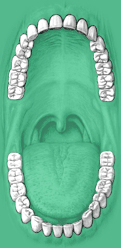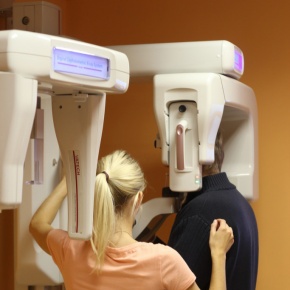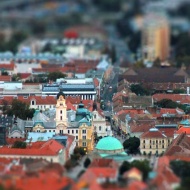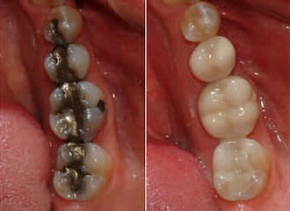
The inlay is made in two sessions. For the first time the preparation, the impressing and the chew-in record, which will be then at the dental technician. Usually it is get ready during a day or two. During this time in the tooth will be temporary filling. After the dental technical work the doctor fixes the completed inlay with special glue or with cementation depends on the inlay’s material.
It is highly durable and aesthetic filling type. It should be made when the decay extended two or more parts of the tooth surface, or next to the removed filling the decay affects one or two osculant adjacent tooth surface. It is absolutely indicated for the replacement of the old, large scale amalgam fillings, or for the cusps’ restoration, and for root canal treated teeth’s covering. It can be considered its huge advantage that with the use of the inlay the remained tooth quantity can be saved, and may be retained. We can create inlay due to aesthetic reasons (the back tooth discolored, the tooth’s structure is inherently wrong), if the tooth is formally inappropriate and its masticatory is insufficient. We can use the inlays also for the restoration of the missing teeth. In this case the inlays which are in the gap bounding adjacent teeth keep the fixed partial denture (so called anchored fix partial denture with inlay). Today, from the available inlay types taking into the account the functional and aesthetic needs and financial possibilities there are a number of possible solutions.
One large group of the inlays satisfies high aesthetic needs. The inlays made from the reinforced composite (Belle Glass, Gradia) and ceramics (pressed ceramic, Empress) provide satisfaction for 8-12 years for our patients. In the visible side zone, in the case of back teeth it is also an excellent solution for complement the missing tooth part, for aesthetic beatification of the teeth, and for restoration the teeth. With its application it can faithfully imitated any tooth shade, its individual coloration, thus your smile will be harmonious and pleasant; your teeth get individual characters. Our applied aesthetic inlays’ quality and accuracy is outstanding, their chewing stability, their mouth-resistance offers a long term solution.
BelleGlass: this is a synthetic resin which is reinforced with glass fiber. It is aesthetic, tooth colored. The material in regard to its characteristics is very similar to the tooth. Doesn’t wear off the opposite tooth, doesn’t rigid and fragile.
Gradia: it has similar features than the BelleGlass.
Ceramics: from various material and technology can be prepared ceramic inlay.
Traditional ceramics: Very aesthetic, beautiful restoration, more transparent than the BelleGlass or Gradia, but its physical characteristics are more unfavorable. It is much more rigid, fragile and hard material. Often makes use the teeth. If it is thin, easily snaps, therefore it is with many tooth material’s processes, often with the healthy tooth material, therefore to has proper thickness to prevent the breakage.
Pressed ceramics: it is very hard, less fragile than the traditional ceramics, but proper thickness is needed. Another disadvantage is that the pressing is from one block, so it can’t return as well the color differences within a tooth.
Burned ceramic inlay to the Galvan gold: its basis is a thin gold layer, which is very accurate due to the technology.
They burn into this the porcelain layer, which gives the real form of the inlay. Its disadvantage is that the gold edge is sticking out from the ceramic, so on the edge of the inlay a thin gold edge appears, which provides very well closure to the inlay. Another disadvantage is purely aesthetic; because the gold’s yellow color affects the color of the inlay, mainly in those spaces where the ceramics is thin on it.
Burned ceramics into the zirconium oxide skeleton: This type of inlay is made with the newest technology. Its basis consists of a white metal oxide skeleton, which is made with a highly special technology.
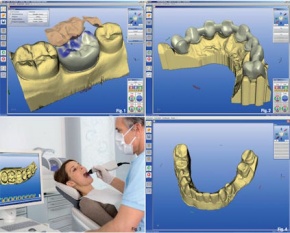
The prepared cavity’s picture the technician enters with the help of a camera into the computer, which makes virtually the skeleton with the help of special software. Sends this information to the specialized laboratory, which can be in Germany or in Sweden. They prepare here the final skeleton which sent back to the dental technician’s laboratory can prepare the inlay. Its advantage is that it is very-very accurate, very aesthetic.
Its disadvantage is that due to the technology the preparation is longer and costly. We recommend the gold inlay to those patients who are looking for a long-term, demanding and durable solution in an excellent quality up to 15-20 years. The perfect border closure (the inlay’s fit to the teeth), the appropriate chewing stability, durability, the repelling ability of bacteria in any case can listed as this inlay type’s advantage.
Only disadvantage can be mentioned that it is not tooth colored, but its surface can veneering with porcelain. Considering the price-value rate it is an excellent investment. Its disadvantage is also that it is non-allergic.

